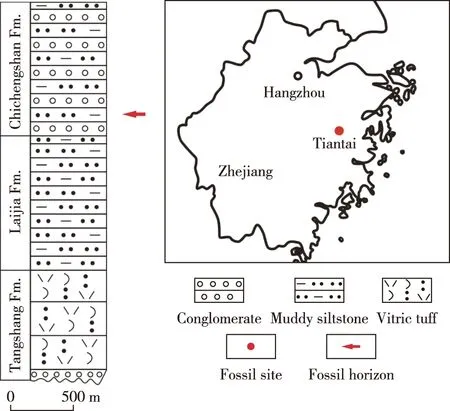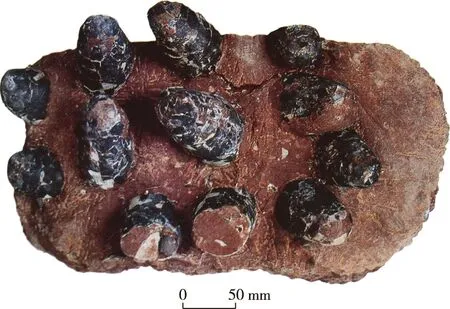A Cretaceous troodontid laid her pairs of eggs vertically and arranged spirally in a nest
Qian Maiping, Duan Zheng, Ma Xue, Chen Rong, Zhang Xiang, Yu Minggang, Zhao Qian
(1. Nanjing Centre of China Geological Survey, Nanjing 210016, Jiangsu, China; 2. East China Mineral Exploration and Development Bureau, Nanjing 210007, Jiangsu, China)
Abstract: Unlike other dinosaurs, the troodontids laid their eggs standing up in loose sands or muddy soil. The clutch of fossil troodontid eggs in the Upper Cretaceous Chichengshan Formation from Tiantai Basin, Zhejiang Province, China indicated that these creatures produced a pair of eggs every time in open nests and covered them with sands or muddy soil and laid their eggs starting at the center of the nest, then screwed in turn outward laying more than 20 eggs per nest. It suggests that a female troodontid had a pair of functional oviducts as that of oviraptorosaurs, and laid her eggs again and again in a single nest and perhaps looked after these eggs frequently. The troodontid eggshell, furthermore, was rigid as that of some modern bird eggs and strong enough to resist pressure while the eggs were forced into sands and muddy soil when they were laid. Some of the other dinosaur eggshells, in contrast, were stretchable as those of some modern reptiles.
Key words: troodontid; fossil egg; nesting behavior; twain functional oviducts; Tiantai, Zhejiang
0 Introduction
The troodontid dinosaurs were a group of small, bipedal, bird-like theropod with exceptionally long legs and forward-pointing eyes, which suggests that they were fast runners with keen eyesight. A troodontid had a very large brain compared to its body size, indicating a high level of intelligence, comparable to those of living flightless birds. Besides, they probably had feathers covered with them (Currie et al., 2001). A fossil troodontid egg appeared in an elongated spheriform, with one end wide and round while the other end pointed, preserved standing up in siltstones with pointed end downwards (Horner, 1984; Zhao et al., 1993; Zhao, 2000, 2003). Here the paper will discuss the nesting behavior and physiological characters of troodontids, and the significance on evolution with the fossil nest from the Upper Cretaceous Chichengshan Formation in the Tiantai Basin, Zhejiang Province, China.
The fossil troodontid eggs ofPrismatoolithuswere first found in the Upper Cretaceous Two Medicine Formation (Horner et al., 1979,1988; Horner, 1984) and initially described as prismatoolithid eggshells (Hirsch et al., 1990) and assigned to the small ornithischia hypsilophodontidOrodromeusmakelai, based on embryonic remains within fossil eggs from Western Montana, USA (Horner et al., 1988). It has, however, been announced (Horner et al., 1996) that the initial identification of these embryos was erroneous. They were re-identified as the small theropodTroodonformosus, rather thanOrodromeusmakelai.
The fossil records of prismatoolithid eggshellsPrismatoolithusso far included specimens from the Upper Cretaceous in Languedoc, Southern France (Vianey-Liaud et al., 1993), the Upper Jurassic Morrison Formation in Colorado, USA (Hirsch, 1994), the Upper Cretaceous Oldman Formation in southern Alberta, Canada (Zelenitsky et al., 1996), the Cretaceous of Mongolia (Mikhailov, 1994), the Lower Cretaceous of the Xixia Basin in Henan (Wang et al., 1995), the Upper Cretaceous Pingling Formation of the Nanxiong Basin in Guangdong (Zhao, 2000) and the Upper Cretaceous Chichengshan Formation of the Tiantai Basin in Zhejiang (Qian et al., 2008a). It is suggesting that troodontids had migrated and thus diffused intercontinentally when Aisa, Europe and the North America united each other, and they successfully adapted to various environments of those continents with their unique nesting and laying eggs behavior.
1 Fossil preservation
Since the middle 1990s, thousands of fossil eggs and skelectons have been unearthed from the Upper Cretaceous Chichengshan and Laijia formations of the Tiantai Basin in Zhejiang Province, eastern China (Fig. 1). They, heretofore, include 6 oolithgenus, viz.Elongatoolithus,Macroelongatoolithus,Spheroolithus,Paraspheroolithus,OvaloolithusandDendroolithus(Fang et al., 2000, 2003; Qian et al., 2007, 2008b, 2009, 2012; Jiang et al., 2011, 2016). Based on embryonic remains within fossil eggs from the Gobi of Mongolia, the Erlian of Inner Mongolia, Xixia of Henan, Montana and Patagonia etc., these oolithgenus perhaps were assigned respectively to various dinosaurs, for example, oviraptorosaurs (Norell et al., 1994, 2001; Manning et al., 1997), therizinosaurs (Manning et al., 1997) and titanosaurs (Chiappe et al., 1998, 2001) etc. ThePrismatoolithusdiscovered from the Chichengshan Formation suggests the troodontids also lived in the Tiantai Basin then (Qian et al., 2008a).

Fig. 1 The fossil troodontid eggs found site and strata in the Tiantai Basin, China
The fossil eggs in troodontid nests appeared standing up, vertically or obliquely in reddish purple siltstone. This suggests that troodontids moved in torridity riverside or lakeside and could take floppy sandy or muddy soil shore as their nesting site and put their eggs vertically into earth when they were laid. The fossil troodontid egg from the Tiantai Basin is about 110 mm in length, and about 50 mm in extreme breadth. The eggshell is black-gray, very thin and smooth. There are fine parallel striations randomly distributed on the outer surface of the eggshell. These longitudinally oriented striations on the eggshell surface could be produced by rubbing when the egg was forced into the sediment. The incomplete troodontid nest found in Tiantai Basin contains more than a dozen of eggs laid in pairs. All pairs were in vertically or almost vertically parallel arrangement, 30-50 mm apart mostly, with the locus of laying eggs in a plane of a point moving around the center of nest at a monotonically increasing distance from the center. The distance of pairs of eggs in the first circle to the center is about 100 mm, and that of the second circle is about 200 mm (Fig. 2). It is conjectured that a complete troodontid nest perhaps contain more than 2 or 3 circles and up to more than 20 eggs.

Fig. 2 Troodontid eggs in pairs arranged spirally in a part of the nest from Upper Cretaceous Chichengshan Formation in Tiantai Basin of Zhejiang Province, China(now collected in the Zhejiang Museum of Natural History)
2 Discussion
Troodontids laid eggs in pairs like theropods, oviraptosaurs, and their generative system were conform, namely, both troodontids and oviraptosaurs have a pair of functional oviducts. It is known that the closest living relatives of dinosaurs, i.e., birds and crocodiles, lay eggs in different ways. Crocodiles and other modern reptiles have a pair of functional oviducts and lay their clutch of eggs in a sitting. In contrast, birds have only 1 functional oviduct and lay 1 egg at a time. Modern alligators spend about 3 weeks to form the shells on a whole clutch of eggs whereas birds deposit the shell layer on their single egg in 1 to 2 days. Producing and laying only 1 egg at a time saves weight, making flight easier. The generative systems of troodontids, oviraptosaurs, probably and other theropods, were an interim type between crocodiles and birds. Each of the troodontid′s twain functional oviducts formed an egg and laid a pair of eggs at a time, like an oviraptosaur (Sato et al., 2005). A troodontid laid her pairs of eggs again and again, infixed them into the sediment and arranged them spirally in a single nest.
The troodontid eggshell was rigid as that of some modern bird eggs and strong enough to resist pressure while the eggs were forced into loose sands and muddy soil when they were laid. Some of the other dinosaur eggshells, in contrast, were stretchable as those of some modern reptiles. So some of the dinosaur eggs appeared in flat sphericity or flat ellipse by gravity, for example, fossil eggs ofSpheroolithus,Paraspheroolithus,ElongatoolithusandMacroelongatoolithusfrom the Upper Cretaceous Chichengshan Formation in the Tiantai Basin (Fang et al., 2000, 2003; Qian et al., 2007, 2008b, 2009, 2012).
The manner of an adult female troodontid laying eggs involved a very unique nesting behavior of taking loose sandy or muddy soil shore as her nesting site, and laying firstly a pair of eggs at the center of her nest and burying them, and after a period of time laying another pair of eggs by the side with a little distance, and then again and again laying in turn spirally outward more than 20 eggs in the nest. It is suggesting that this creature lay her eggs constantly in a certain nest and perhaps look after these eggs and infants frequently.
3 Conclusions
The fossil nest with brooding troodontid eggs from the Upper Cretaceous Chichengshan Formation indicating.
(1) A female adult troodontiod had a pair of functional oviducts, evolutionarily between single functional oviduct of modern aves and twain functional oviducts of primordial reptiles.
(2) They laid 2 eggs at a time in a certainty sitting.
(3) They laid first pair of eggs at the center of the nest and buried them, and then laid subsequent pairs of eggs in turn spirally outward more than 20 eggs in the nest.
(4) They perhaps looked after these eggs and infants frequently.
Acknowledgments
We would like to express our deep gratitude to engineer Jiang Yan′gen from Tiantai Bureau of Land and Resources for giving us his full support during the field survey.

